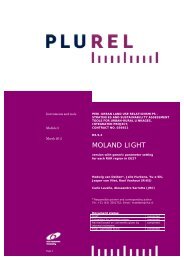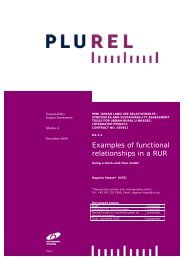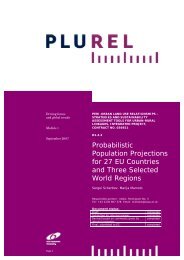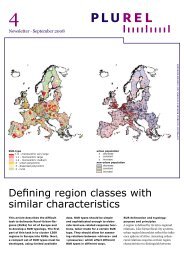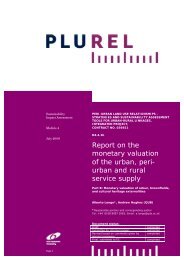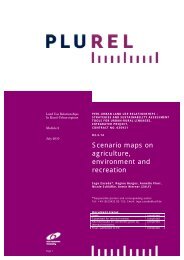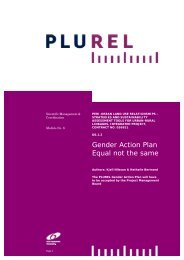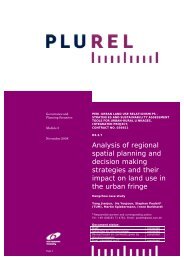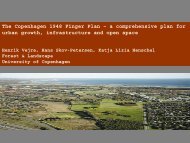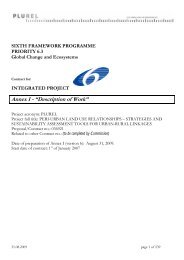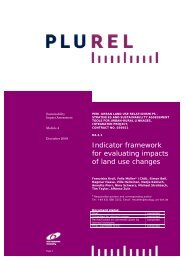Cost benefit analysis of peri-urban land use policy - Plurel
Cost benefit analysis of peri-urban land use policy - Plurel
Cost benefit analysis of peri-urban land use policy - Plurel
Create successful ePaper yourself
Turn your PDF publications into a flip-book with our unique Google optimized e-Paper software.
The Study Area and Scenario Analysis<br />
Greater Dublin Area (GDA)<br />
Greater Dublin Area (GDA) consists <strong>of</strong> not only the business and <strong>urban</strong> core <strong>of</strong> Dublin, but also the<br />
surrounding Counties <strong>of</strong> Kildare, Meath, and Wicklow. The area has a <strong>land</strong> cover <strong>of</strong> around 7,000<br />
km 2 , and has a total population in excess <strong>of</strong> 1.6 million (CSO, 2007). There are seven local authorities<br />
governing the area. Four <strong>of</strong> them i.e. Dublin city, Dun Laoghaire-Rathdown, South Dublin and Fingal<br />
comprise the Dublin Region, while the other three are in the adjacent counties including Kildare,<br />
Meath and Wicklow (see Figure 1).<br />
Dublin Area is considered as one <strong>of</strong> the most negatively affected cities by sprawl development<br />
patterns within the European Union in the study carried out by European Environment Agency (see<br />
EEA, 2006: 13). According to Williams et.al. (2007), “the outward extension <strong>of</strong> the commuter belt<br />
reaches over 100 kilometres from the Dublin area into Outer Leinster and now adjacent to Ulster<br />
counties <strong>of</strong> Monaghan and Cavan” (Williams et.al. 2007: 6). Considering the uncontrolled <strong>urban</strong><br />
growth that the Dublin Area has ex<strong>peri</strong>enced from early 1990s, problems in transportation and <strong>land</strong><strong>use</strong><br />
planning have also contributed to sprawl type development patterns in the <strong>peri</strong>-<strong>urban</strong> areas <strong>of</strong><br />
the Dublin Region. Since this is the case, the Region has required further examination considering<br />
future <strong>land</strong> development processes and new infrastructure provisions.<br />
There are recent attempts in the GDA related to Regional Plans for GDA and the Transport21 project<br />
which aim to achieve coordination between transportation/infrastructure provision and <strong>land</strong>-<strong>use</strong><br />
development and planning. Regional Plan is searching solutions to mitigate the effects <strong>of</strong> <strong>urban</strong><br />
sprawl by focusing on new development centres beyond the Dublin Metropolitan Area. Transport 21<br />
Plan, on the other hand, gives importance to the transportation projects which strengthen the role <strong>of</strong><br />
existing <strong>urban</strong> settlements or the settlements having the potential <strong>of</strong> attracting new residential or<br />
industrial growth (see Figure 2). Transport 21 covers the <strong>peri</strong>od 2000-2016, and aims at “managing<br />
travel demand by reducing overall travel and by increasing share <strong>of</strong> public transport” (Ellis and Kim;<br />
2001: 363). There is specific emphasis on the rail investments including light rail and metro in order<br />
to achieve more compact and mixed developments along the rail lines and in <strong>urban</strong> centres. In<br />
relation with the goals set in Planning Guidelines and Transport 21 Investment Programme, the<br />
three scenarios derived from the MOLAND Model will be evaluated in the next section.<br />
64



